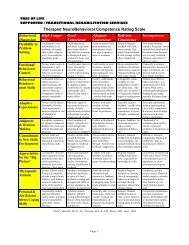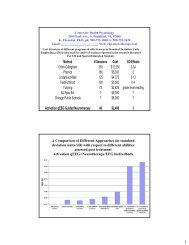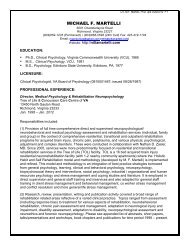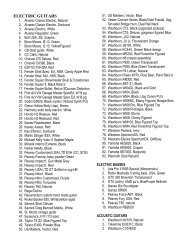Slull reacquisition after acquired brain injury - villa martelli disability ...
Slull reacquisition after acquired brain injury - villa martelli disability ...
Slull reacquisition after acquired brain injury - villa martelli disability ...
Create successful ePaper yourself
Turn your PDF publications into a flip-book with our unique Google optimized e-Paper software.
120 M.E Martelli et al. /Skill <strong>reacquisition</strong> afier <strong>acquired</strong> <strong>brain</strong> ir~jury<br />
Table 1<br />
Five commandments of rehabilitation<br />
Commandment 1: Thou Shall Make Only Accurate Comparisons. Thou shall not make false comparisons.<br />
That is, it is only fair (and adaptive) to compare oneself to persons with similar injuries, illnesses, disabilities and stress, as this comparison<br />
allows us to accurately measure ourselves. It is unfair to compare ourselves to others without similar challenges, or to ourselves before we<br />
were challenged, as this makes us look poor by comparison.<br />
Commandment 2: Thou Shall Learn New Ways to Do Old Things.<br />
Learning new ways, or finding another way to do desired tasks, vs. giving up & feeling hopeless because the old way doesn't work, is the<br />
key to Challenging obstacles and overcoming them.<br />
. . . Overcome thinking that the old way is the best way (i.e., Stinking Thinking)<br />
Commandment 3: Thou Shall Not Beat Thyself Up . . . Instead, Thou Shall Build Thyself Up!<br />
We clearly understand that when we have a physical <strong>injury</strong>, such as a broken leg, getting mad, yelling at, or hitting (i.e., beating up) the leg<br />
only delays recovery, increases symptoms and pain, and makes us and the leg function worse. We know that pampering the leg, massaging it<br />
and coaxing it along gently & patiently will help it recover. Unfortunately, we too often forget that our <strong>brain</strong>s are similar. An injured <strong>brain</strong><br />
will perform poorly when we get mad with it, or get frustrated. Instead, understanding it, pampering it, being patient, using pacing & coaxing<br />
it along in a supportive way will help us function our best, and help our recovery and rehabilitation. Talking to ourselves in supportive and<br />
understanding ways (vs. getting mad at ourselves for being injured or having difficulty) and coaxing things out gently is a good way of<br />
building ourselves up in order to face the challenges of rehabilitation. Rewarding ourselves for efforts and each small step of progress, despite<br />
tremendous obstacles & challenges, is the best way to build ourselves up!<br />
. . . Child & Spouse Abuse are recognized as illegal and intntoral . . . Sey'Abuse is just as bad!<br />
Commandment 4: Thou Shall View Progress as a Series of Small Steps.<br />
Rehabilitation is appropriately viewed One Step At a Time - by focusing on the gains over where we were when we were one step behind<br />
where we are now, we can focus on the Graduated Successes and feelings of accomplishment (despite giant obstacles) which will leave us<br />
feeling proud and hopeful and enable us to focus and reach the next small step ahead, and make progress through the many small steps<br />
necessary to make substantial progress. Focusing on our current gains and small steps of progress (compared to where we were earlier in<br />
rehab and when we were at our worst) will build hope and a sense of challenge and growing victories (versus comparing ourselves to before<br />
the <strong>injury</strong>, which only makes us feel sad & depressed.<br />
. . . Inch by Inch & It's a Cinch. Meter by Meter; Lifi. is Sweeter:<br />
Commandment 5: Thou Shall Expect Challenge & Strive to Beat It.<br />
By Converting Complaint (I don't want) To Challenge (I want), We Can Shape Our Future Through Our Vision and Driving Thoughts. We<br />
will actively shape our future by focusing on a vision of hope, challenge, control & satisfaction. By changing our focus from complaint<br />
and feelings of victimization & helplessness & pessimism, we can avoid giving up and giving in to a pessimistic prophecy of dissatisfaction<br />
and doom. (cf. "Thou Shall not Pretend to Have a Contract Guaranteeing Freedom from Injury, Disease, Illness or Unfair circumstances or<br />
Significant Stress!")<br />
M.E Martelli, Ph.D: @ 1995<br />
The prescribed attitude "antidotes" captured in<br />
the "Five Commandments of Rehabilitation" are the<br />
essence of the "medicines" that interrupt the rehabilitation<br />
"poison" cycles. Energy tends to be selfpropagating<br />
in a cyclical fashion. Given negative expectancies<br />
and hopelessness, more energy is expended<br />
nonproductively. This depletes and redirects limited<br />
energy and resources away from allocation toward<br />
adaptive relearning and rehabilitation accomplishments.<br />
A habitual depressive response to physical<br />
losses can reduce activity, prevent adaptive relearning,<br />
and lead to increased depression by depletion of<br />
<strong>brain</strong> chemicals associated with positive mood and energy<br />
[46,50]. Ongoing depression, in turn, leads to<br />
poorer progress, more negative expectancy and confirmation<br />
of reasons to be depressed.<br />
The "Five Commandments" represent a cognitive<br />
behavioral prescription for a more positive vision of a<br />
gradually improved future necessary for planning and<br />
successfully practicing compensatory cognitive and be-<br />
persons against depression, anger, and other destructive<br />
emotion. This ensures that energy and motivation will<br />
be available for the persistent pursuit of desired goals,<br />
with each step of progress adding momentum for con-<br />
tinued hope, self-efficacy, energy, and continued effort.<br />
With the addition of potent learning strategies like task<br />
analyses, errorless learning strategies, and scheduling<br />
to help promote routines, energy is increasingly pro-<br />
tected and positively allocated through adaptive inter-<br />
pretations and expectancies. In a cyclic fashion, energy<br />
fueling consistent repeated practice turns these rehabil-<br />
itation promoting strategies into incremental success-<br />
es and increasingly automatic habits. These produce<br />
continued achievements and energy that strengthen the<br />
adaptive interpretations and expectancies that strength-<br />
ens adaptive energy.<br />
To summarize, any behavior that is structured and<br />
consistently repeated will eventually become a habit.<br />
The HHR model promotes both the activity and attitude<br />
routines that will mobilize energy for practicing potent<br />
learning strategies that will help shape patient efforts<br />
havioral strategies. Simultaneously, they help inoculate toward their important goals.








